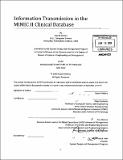Information transmission in the MIMIC II clinical database
Author(s)
Mishra, Rajesh, S.M. Massachusetts Institute of Technology
DownloadFull printable version (19.00Mb)
Alternative title
Information transmission in the Multiparameter Intelligent Monitoring in Intensive Care two clinical database
Other Contributors
System Design and Management Program.
Advisor
Peter Szolovits and Roy Welsch.
Terms of use
Metadata
Show full item recordAbstract
The promise of the Electronic Medical Record (EMR) to store, retrieve, and communicate medical information effectively for a caregiver team has remained largely unfulfilled since its advent in the late 1960's. Previous studies have cited that the communication function of the EMR is critical to its successful adoption. Based on Mediated Agent Interaction theory, this study proposes a message-based model of transmission of clinical information in the EMR. This model is implemented on an existing ICU clinical database, MIMIC II, to produce a database of transmission events. Three metrics for information transmission are derived from exploratory and object-attribute analyses: transmission volume, duration, and load (or rate). Also derived is a set of features that includes a patient's clinical conditions (with acuity scores and mortality), caregiver type and distribution, care-unit locations, duration of care, and types of clinical records. This list of features is reduced to a set of explanatory variables using correlation and univariate logistic regression. Bayesian Network (BN) models are constructed to predict levels of the transmission metrics. BN models show high prediction accuracy for measuring various levels of messaging volume and load, but marginal accuracy for messaging duration. Results from these methods suggest that the volume of information transmitted in the ICU for adult patients is primarily through charts entered by nurses and respiratory technicians (RTs). The amount of data recorded by RTs increases for patients with higher acuity scores, but transmission from nurses decreases for these patients. The rate at which information is transmitted in the ICU for adult patients is directly related to the rate at which notes and charts are entered, as well as the care-unit location where the data is recorded. Further study is required to investigate factors influencing the length of time information is transmitted in the ICU. This study's findings are based on data recorded by caregivers as clinical observations. Further study is necessary to corroborate these results with clinical communications data, including evidence of reception of clinical information by caregivers. The model proposed by this study may be used as a basis for future research and to discover other patterns of clinical communications.
Description
Thesis (S.M. in System Design and Management)--Massachusetts Institute of Technology, Engineering Systems Division, 2010. Cataloged from PDF version of thesis. Includes bibliographical references (p. 127-129).
Date issued
2010Department
System Design and Management Program.; Massachusetts Institute of Technology. Engineering Systems DivisionPublisher
Massachusetts Institute of Technology
Keywords
Engineering Systems Division., System Design and Management Program.